When I was 16 and taking piano lessons, my teacher Dr. Barbara Thompson held periodic workshops where 6 or 8 students would get together, explore topics and share compositions. I had handwritten several compositions in a notebook, submitted them for grading, and performed all but the last in the workshops.
Here they are, as usual typeset using GNU LilyPond. First, a PDF of the lot:
(1) Spring Birds, my first composition, actually named in 2011 because I hadn’t named it before and that’s what it sounds like to me. I have changed it to use a simple, pleasing ottavation notation, and have left out voice rests that unnecessarily complicate the simple score. It should be quite trivial to learn for someone who’s heard it. Otherwise, it might take some consideration.

(2) Invention, a short, fast, staccato piece in C minor.
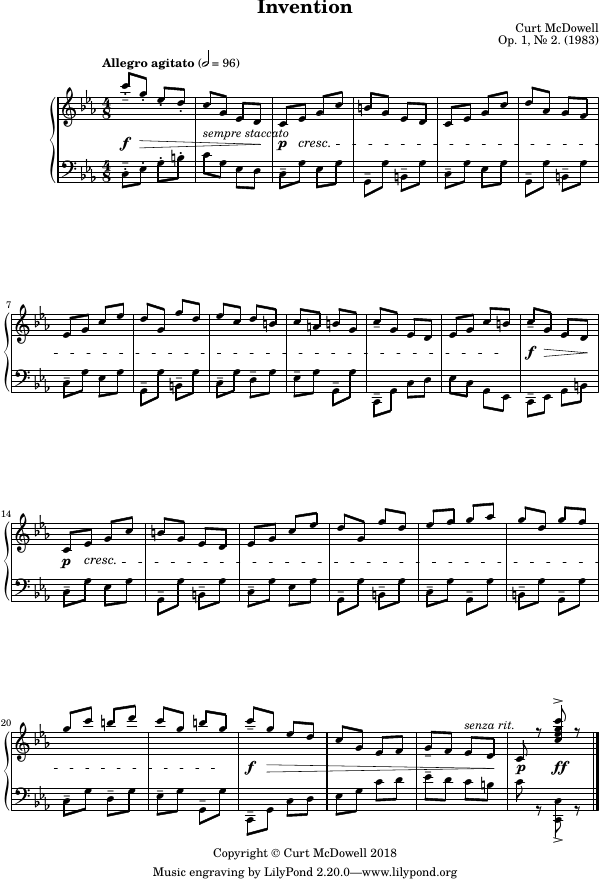
(3) Vivace, a terribly short couple lines that is the least of them.
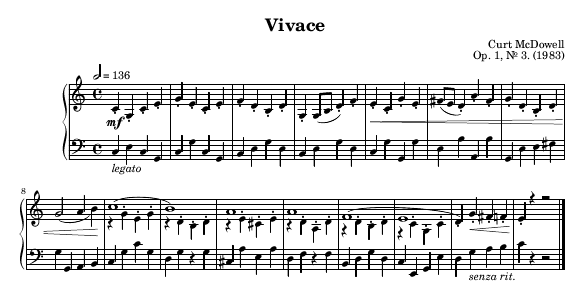
(4) May Daze, with the name gratuitously taken from an event at the Lehigh Valley Hospital Center back in the day. The goal assigned for this piece was to demonstrate key changes as well as a contrapuntal theme that repeated in different voices.
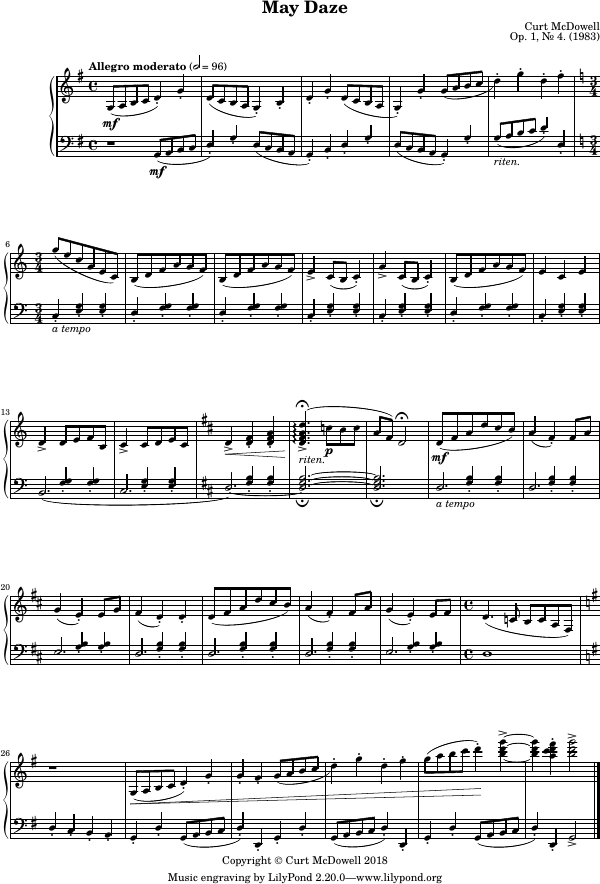
– Warning: some of the tied chords don’t play as tied in the MIDI.
(5) Goldfish Rock, the most fun I think. The syncopated rhythm is hard to grasp at first. At least, so said Mrs. Thompson but she gave it an “A”.
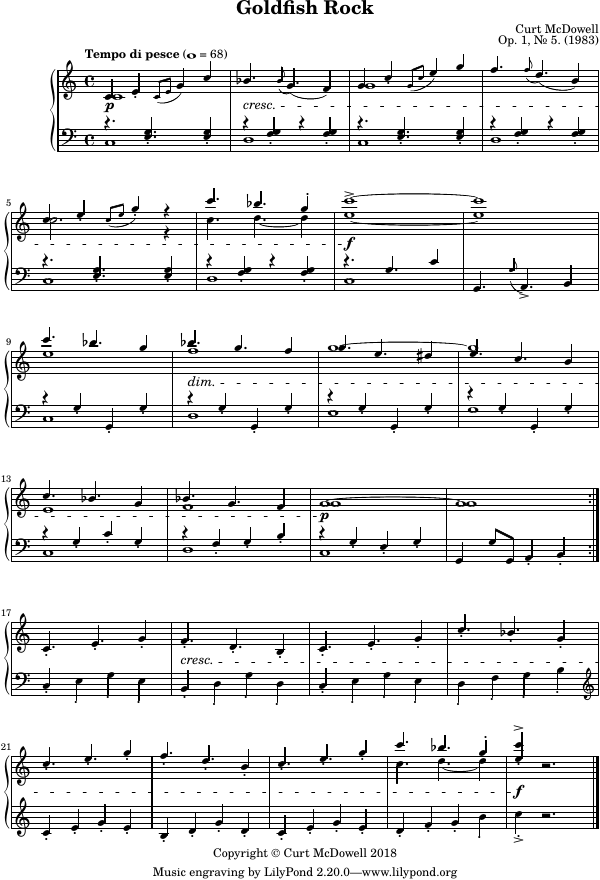
(6) Commodore. This sixth piece was inspired by a two-voice tune that I heard playing on a demo of an 8-bit computer in a Computerland store at the Lehigh Valley mall. It may have been a Commodore VIC-20 or possibly a Sinclair ZX81. Please let me know if you can identify it, which might only be possible if I haven’t scrambled too bad.
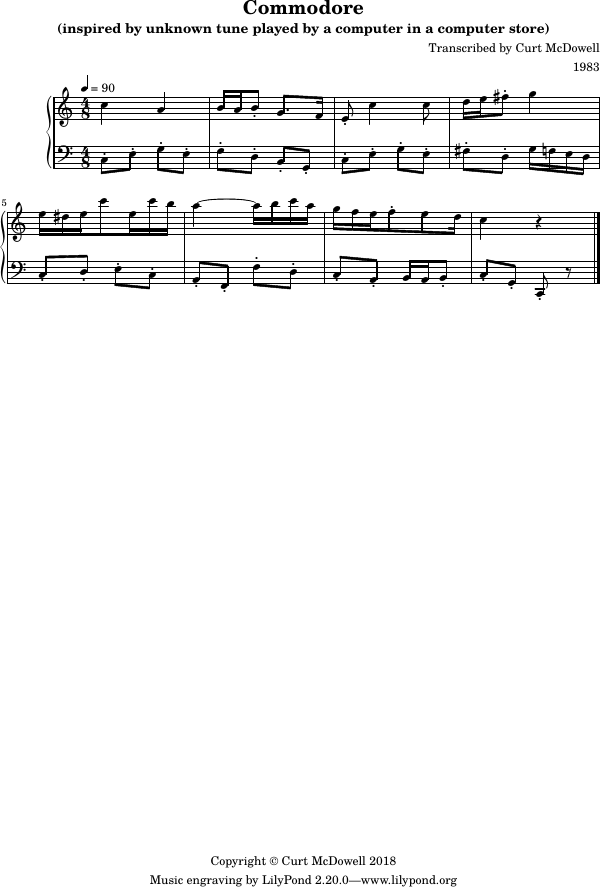
Thank you for trying these admittedly primitive pieces and let me know if you like them!
A few years ago I received the gift of a Rhythm Clocks musical wall clock. Every hour on the hour, it plays one of several short song excerpts. Somehow I identified one of the songs (possibly using SoundHound?) to be a popular waltz from an opera of Delibes.
Title: Coppélia – Waltz from Act I – Valse Lente
Composer: Clémont Philibert Léo Delibes (1836-1891)
I downloaded sheet music for it, edited by Ricardo Boppré. It turns out it was a slightly simplified version that had also been transposed from E flat major to C major. With a GoPro camera I recorded myself playing it for YouTube, here. This has reached 20K+ views, not so deservedly, but this shows the song itself is quite popular.
More recently, I found the “original” E flat version upon which Boppré’s version clearly had been based. I decided it isn’t much more difficult, so I didn’t feel the existence of the C major version was fully justified, and wished I’d recorded the original.
Editor: Henri Heugel
Publisher: Heugel et Compangnie, Au Ménestral, Paris
Date: 1870
I typeset this version into the GNU LilyPond music formatting software. As with Le Chemin de Fer, I tried to make the output look just like the 1870 version, although I didn’t take it quite as far. Here is the LilyPond source file:
The MIDI file generated by LilyPond:
You can play the MIDI file in your browser using the tools from www.midijs.net, but I recommend downloading the MIDI file and playing it natively.
And the PDF file of the sheet music:
With LilyPond, it is near trivial to transpose a piece. In the source code, I have two lines setting the variable “transposeKey”. Simply uncommenting one line or the other selects which key. For grins, here is the C major version of the sheet music:
My first major project using the GNU Lilypond music typesetting software was to re-typeset the piano piece Le Chemin de Fer (The Rail) by Charles-Valentin Alkan. I had seen performances of this fun and ridiculously fast piece on YouTube and tried learning it myself.
Part of the motivation was to create a MIDI file to play it at Alkan’s insane indicated tempo of 112 to the half note, which equates to the right hand playing continuous scales and arpeggios at a rate of nearly 15 notes per second.
I had retrieved a PDF file of the M. R. Braun edition from here. It’s a fancy, historic typeset of this piece. I decided to see how close to identical I could get with Lilypond. It’s not perfect but I can’t imagine getting any closer with other typesetting software. Some of the challenges included:
The LilyPond file is organized into 20 sections, 10 for the left hand and 10 for the right.
The MIDI file is automatically generated when LilyPond is run.
You can play the MIDI file in your browser using the tools from www.midijs.net. The speed is indeed ridiculous.
The final PDF file!
Watch an unbelievable performance of the piece. There are a surprising number of good performances on YouTube, plus many MIDI renditions.